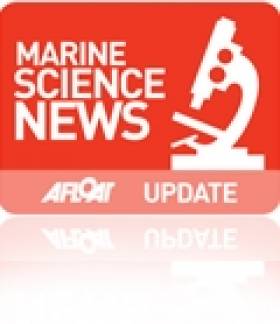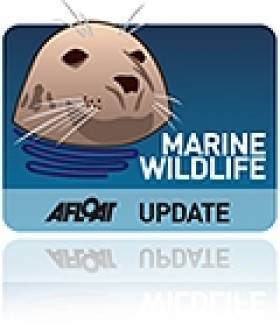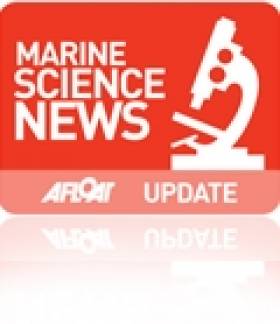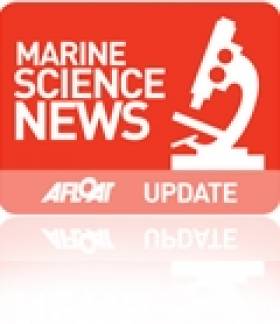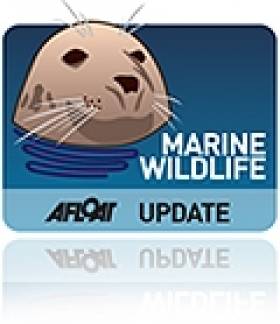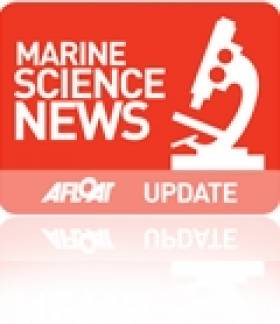Displaying items by tag: Marine Institute
Irish Marine Science Chief Appointed to European Research Board
#marinescience – Dr. Peter Heffernan, CEO Marine Institute, has been appointed to the European Research and Innovation Area Board (ERIAB) by European Commissioner for Research, Innovation and Science Máire Geoghegan-Quinn. The 11 member board advises the Commissioner on issues relating to the development of the European Research Area, including the €80 billion Horizon 2020 Programme for Research and Innovation (2014-2020). Members of the ERIAB are appointed for a four year term and the mandate of current ERIAB extends to February 2016.
"I look forward to working with Dr. Peter Heffernan as a member of the European Research and Innovation Area Board, ERIAB," said Commissioner Geoghegan-Quinn. "In the coming years, ERIAB will play a vital role in the development and optimisation of the European Research Area. Members of ERIAB are highly respected scientific and policy advisors who will draw on their extensive experience at national and international level, and I am delighted to have an Irish member of Peter's calibre on board".
The Taoiseach Mr Enda Kenny, TD said the appointment represented an important recognition not only of Dr Heffernan's own contribution but also of the work of the Marine Institute over the years. "Ireland and Europe share many objectives in supporting sustainable ocean economic activities as an important engine of growth in our recovery. I have no doubt that Peter's contribution to ERIAB will be very beneficial in this regard".
Welcoming the announcement, Minister for Jobs, Enterprise and Innovation, Mr Richard Bruton, TD, congratulated Dr Heffernan on his appointment which he said not only reflected Dr Heffernan's standing in the European research community, but also that of Irish science, technology and innovation.
Minister for Agriculture, Food and the Marine, Mr Simon Coveney, TD, joined in congratulating Dr Heffernan, and noted that this appointment also acknowledged the importance of marine science, technology and innovation for the European Research Area, a topic Dr Heffernan has championed both in Ireland and in Europe.
The ERIAB plays a key role in developing, promoting and evaluating EU research, development and innovation policy initiatives and actions, including the further development of the European Research Area (ERA), the implementation of the proposed €80 billion Horizon 2020 Programme (2014-2020) and the Europe 2020 and Innovation Union Strategies. Europe 2020 is a 10-year strategy aimed at reviving the economy of the European Union through "smart, sustainable, inclusive growth, with high levels of employment and living standards".
In July 2012, the Irish Government, through the interdepartmental Marine Co-ordination Group, launched Harnessing Our Ocean Wealth – An Integrated Marine Plan for Ireland, setting out a roadmap to harness the potential of Ireland's marine resource. This plan, part of the marine sectors contribution to the Europe 2020 Strategy, will contribute to the development of the Action Plan of the European Union Strategy for the Atlantic (EUSA) which will have a major bearing and influence on the topics to be supported by EU Structural, Regional, Research and Environment Funds between 2014 and 2020.
Porbeagle Sharks Tagged & Tracked Online by Marine Institute
#shark – October 2012 marks an important milestone for the Marine Institute and Irish Elasmobranch Group's porbeagle shark tagging project as five more porbeagles have been tagged off the Donegal coast by the project's expert shark angler, Peter McAuley. The project, which has been ongoing since 2008, is now offering the public an opportunity to track the movements of two sharks in near real time on the Irish Elasmobranch Group's website, www.irishelasmobranchgroup.org.
Five sharks were tagged with conventional pop-up satellite tags, which will record the sharks' location and depth, over a nine month period. After this, the tags are programmed to detach, float to the surface and transmit the data to orbiting satellites. In addition to the pop-up tags, two of the tagged sharks were fitted with Smart Position or Temperature Transmitting (SPOT) tags. These tags are fitted on to the dorsal fin of the sharks and each time the fin breaks the water's surface, a position is transmitted to an orbiting satellite. This allows the sharks to be tracked in near real time and it is believed that this is the first time these tags have ever been fitted on porbeagles. The tags should function for at least the next year, providing a completely new insight into the behaviour of these sharks.
Porbeagle sharks, which are a very timid species of shark, can grow to over three metres and 250 kilograms, and are one of the largest predatory sharks in Irish waters, feeding on fish. Once the target of intensive commercial fishing, the porbeagle shark is now considered to be critically endangered in the northeast Atlantic by the International Union for Conservation of Nature (IUCN). Since 2010, fishing for porbeagles has been banned in European waters; however, as little is known about its biology or ecology, such effective conservation measures are difficult to implement. The research team, comprising Dr. Ryan Saunders, Dr. Maurice Clarke and Dr. Edward Farrell, are attempting to understand the biology and ecology of the porbeagle shark by using advanced satellite linked tagging techniques. The project has already yielded some very important results, the most notable of which was the tagging of one shark, a juvenile male, that migrated over 2400 km from Ireland to Madeira. The movement of porbeagles from European waters to African waters was previously unknown and it has important implications for the conservation and management of the species.
In 2011 the research team was successful in attaining funding from both the Swiss based Save Our Seas Foundation and the German based Naturschutzbund Deutschland (NABU) to continue the project and to build on the important findings already made. Given the large scale movements of porbeagles, collaborations were also developed with the Centre for Environment, Fisheries and Aquaculture Science (CEFAS) in the UK and with the French Research Institute for Exploitation of the Sea (IFREMER).
These five newly tagged sharks also need names so a competition is being organised in collaboration with Galway Atlantaquaria which will give school children the chance to name these five sharks. Details about the competition are available on the Irish Elasmobranch Group website.
#marineinstitute – The Commissioner for Research Science and Innovation visited the Marine Institute in Galway Friday 28th September 2012, together with Robert-Jan Smits, Director General, DG Research Science and Innovation. They participated in a round table discussion with Government officials and research and innovation organisations. The discussions centred around two Irish reports, Harnessing Our Ocean Wealth – An Integrated Marine Plan for Ireland (July 2012) and the Report of the Research Prioritisation Steering Group (March 2012), and their anticipated synergies with the European Blue Growth Strategy, Horizon 2020 and the EU Atlantic Strategy.
The participants included Tom Moran, Secretary General, Department of Agriculture Food and the Marine; Frank O'Mara, Director of Research, Teagasc; Aidan Hodson, Department of Enterprise, Jobs and Innovation; Mark Ferguson, Director General, Science Foundation Ireland; Dermot Clohessy, Industrial Development Authority; Julie Sinnamon, Executive Director, Enterprise Ireland; Tom Boland, CEO, Higher Education Authority; Declan Meally, Sustainable Energy Ireland; and Peter Heffernan, CEO Marine Institute.
Galway Showcases Marine Science on 'Sea2Sky' Research Night
#marinescience – Galway will celebrate European Researchers' Night on Friday 28th September together with 320 cities around Europe. The Sea2Sky event organised by NUI Galway in collaboration with the Marine Institute, Galway Atlantaquaria and its new partner CIT Blackrock Castle Observatory in Cork, will showcase science on the grandest of scales themed around marine science, atmospherics and astronomy.
The main events will be held at the Galway Bay Hotel, Leisureland and Galway Atlantaquaria, with events also taking place in CIT Blackrock Castle Observatory in Cork. Máire Geoghegan-Quinn, European Commissioner for Research, Innovation and Science, will officially open the Irish segment of European Researchers Night at 3pm to coincide with events starting right across Europe.
A variety of interactive stands at Galway Bay Hotel will highlight the work of the Marine Institute showing how Ireland's has a rich and diverse marine ecosystem.
"The Sea2Sky event provides a great opportunity for the wider community to engage with scientists and researchers at a local level in Galway and learn about Ireland's marine resource which is ten times the size of its land mass," said Dr Peter Heffernan, CEO of the Marine Institute.
"As a key step in developing our marine sectors including marine technology, seafood, marine biodiscovery, as well as marine tourism, shipping and oil & gas, it is important at events such as this to help encourage the young people of Galway to consider careers in marine research and science now and in the future," he said.
Celebrating marine science and research the Marine Institute will greet visitors with some of Ireland's most impressive marine science, technology and equipment:
The Marine Institute will be showcasing:
The ROV Holland 1 and a Weather Buoy, which will be on display at the entrance to the main exhibit centre at Galway Bay Hotel. Scientists and technicians will be there to explain the work of the equipment and recent expeditions.
Inside the exhibit area, Marine Institute scientists will be exhibiting their work relating to:
Marine Environment: The phytoplankton team will be highlighting what life is in the drop of seawater - promoting the Marine Institute's responsibility in monitoring algal blooms and highlighting their work in the national shellfish food safety programmes. Visitors to the event will get the opportunity to see take the living "invisible" phytoplankton from a rock pool and look at it under a microscope.
Weather Monitoring and Oceanography: Scientists will show a variety of technology used for providing vital data for weather forecasts, shipping bulletins, gale and swell warnings – some of which have recorded Ireland's largest waves at sea.
Advanced Mapping & the Real Map of Ireland: The advanced mapping team will be show casing INFOMAR and seabed mapping and the extent of Ireland's 220 million acre marine resource along with learning about shipwrecks in the deep sea.
Research Vessel's Operations: The RVops team will be displaying the work of the national research vessels RV Celtic Explorer and the RV Celtic Voyager, as well as the remotely operated vehicle ROV Holland 1 and the special equipment used in different expeditions.
VENTuRE scientific expedition / Biodiscovery and Ecosystem Survey of the Whittard Canyons: A short film will be running throughout the day at the Marine Institute stand, showing the newly discovered and previously uncharted field of hydrothermal vents along the Mid-Atlantic Ridge taken by the ROV Holland 1 last year. Amazing footage of the cold water corals and life under the sea at depths of 3000m taken during the Biodiscovery and Ecosystem Survey of the Whittard Canyons will also be shown.
Explorers Education Programme: The Explorers education officer and her team from Galway Atlantaquaria will also be providing demonstrations to children and school teachers highlighting how the seashore is a vital teaching resource and Through experiments and a variety of demonstrations children will be able to look at life in a rock pool in the Explorers display tank - the Nobby boat.
"Irish researchers are involved in some huge European research projects, and this is an opportunity to share some of the most exciting elements with the public. At third-level, we have seen a surge in applications for science related courses and this event will be a real draw for anyone tempted by a career in science and research," said NUI Galway's Dr Andy Shearer, lecturer in physics and organiser of the event.
Last year, some 10,000 people came to the event, and the plan is for an even bigger event this year, with highlights including the CERN exhibit, 3D tours of the universe and tours of the aquarium. This year visitors can participate in experiments, competitions and quizzes, watch demonstrations and simulations, exchange ideas and get to know the researchers at the free family fun event.
This year, Sea2Sky is linking up with the Galway Science Forum's exhibition about the work of CERN – Accelerating Science. This exhibition, sponsored by Boston Scientific in partnership with NUI Galway, will show how CERN's Large Hadron Collider can help us understand fundamental questions about the origins of the universe.
For further details of the event visit www.sea2sky.ie.
Galway's Sea2Sky Celebrates European Researcher’s Night in Ireland
#MARINE SCIENCE - Galway will celebrate European Researchers’ Night on Friday 28 September together with 320 cities around Europe with its latest Sea2Sky event.
Sea2Sky, organised by NUI Galway in collaboration with the Marine Institute, Galway Atlantaquaria and its new partner CIT Blackrock Castle Observatory in Cork, will showcase science on the grandest of scales themed around marine science, atmospherics and astronomy.
The main events will be held at the Galway Bay Hotel, Leisureland and Galway Atlantaquaria, with events also taking place in CIT Blackrock Castle Observatory in Cork.
“Irish researchers are involved in some huge European research projects, and this is an opportunity to share some of the most exciting elements with the public," said event organiser and NUI Galway physics lecturer Dr Andy Shearer.
"At third level, we have seen a surge in applications for science related courses and this event will be a real draw for anyone tempted by a career in science and research.”
Last year some 10,000 people came to the event, and the plan is for an even bigger event this year, with highlights including the CERN exhibit, 3D tours of the universe and tours of the aquarium. This year visitors can participate in experiments, competitions and quizzes, watch demonstrations and simulations, exchange ideas and get to know the researchers on the free family day.
Among the showcase exhibits at the Marine Institute will be the ROV Holland 1 and a weather buoy. Scientists and technicians will be on hand to explain the work of their equipment and recent expeditions.
Inside, Marine Institute scientists will exhibit work relating to the marine environment (such as algal blooms), weather monitoring and oceanography, advanced mapping techniqyes, research vessel operations conducted by the R/V Celtic Voyager and R/V Celtic Explorer, and the Explorers Education Programme, which highlights the seashore as a vital teaching resource.
There will also be screenings throughout the day of a short film showing the newly discovered and previously uncharted field of hydrothermal vents along the Mid-Atlantic Ridge captured by Holland 1 last year.
Footage of the cold water corals and life under the sea at depths of 3,000 metres taken during the Biodiscovery and Ecosystem Survey of the Whittard Canyons will also be shown.
This year, Sea2Sky is linking up with the Galway Science Forum’s exhibition about the work of CERN – Accelerating Science. This exhibition, sponsored by Boston Scientific in partnership with NUI Galway, will show how CERN’s Large Hadron Collider can help us understand fundamental questions about the origins of the universe.
For further details of the event, visit www.sea2sky.ie.
Algal Bloom Killing Fish, Shellfish Off West Coast
#MARINE WILDLIFE - An algal bloom off the west coast of Ireland is responsible for significant fish and shellfish kills from Galway to Donegal, according to the Marine Institute.
As The Irish Times reports, as much as 80% of stocks have been affected on Donegal oyster farms, and the bloom is also impacting negatively on angling tourism in the west and northwest.
The algae responsible, karenia mikimotai, occurs naturally in Ireland's coastal waters during the summer months and his harmless to humans, but contains a "toxic irritant" that damages the gills of fish, shellfish and other marine species.
Low-level samples were first detected in May but in the last two weeks it has grown into a dense bloom from Donegal to Mayo, with high levels now being recorded in Galway Bay, according to the Marine Institute's Joe Silke.
"In Donegal the bloom was so dense that there were many reports of discoloured red or brown water in some areas and several areas have reported dead marine life washing up on the shoreline, requiring local authorities to close certain beaches,” he said.
"The bloom affects species that live on or near the sea bed so we are seeing flatfish, lugworms and some shellfish getting washed up on the beaches."
The image evokes memories of the notorious 'red tide' that killed wild fish and shellfish along the west coast in 2005.
Meanwhile, the Marine Insitute said there are "some indications" that the bloom may be moving back out to sea, as observed in the latest satellite images and modelling data.
"However, cell counts of samples analysed in the Marine Institute... show that the bloom is still of the same density in the Donegal and Sligo regions as it was last week."
Ports & Shipping Review: Champagne Voyage, Cruiseship Safety, Scienceship, Ferry Sold, P&O 175th,Belfast Boost
#PORTS & SHIPPING REVIEW - Over the last fortnight Jehan Ashmore has reported from the shipping scene which saw the second WFSV Gardian 10 make a delivery 'Champagne 'promo-voyage to her UK East coast based owners.
Following the Costa Concordia incident, tighter inspections of vessels visiting our ports will be carried out according to the Marine Survey Office.
With all things scientific with the ESOF conference in Dublin, as part of Dublin City of Science 2012, there is still time to apply for the Marine Institute's training position for their research vessel operations.
The last ever passenger (incl. car-ferry) built by Harland & Wolff in 1981, the St. David for Sealink/British Rail departed on her long delivery voyage for new Indonesian owners. For most of her career she served as the Stena Caledonia on the North Channel routes until her recent sale and renaming to Portlink.
P&O Cruises Arcadia sailed into Dublin Bay following a spectacular gathering of her fleetmates in Solent waters to celebrate the 175th anniversary of the world famous shipping company. P&O can trace their origins with an Irish connection as the Dublin and London Steam Packet Co. chartered their paddle-steamer William Fawcett, the vessel being regarded as the first ship working for P&O.
Belfast Harbour revealed record traffic levels for the year 2010-2011 as outlined at the company's annual report. The port showed a 2% rise in profit before taxation to £17.8m and a 4% increase in turnover to £36.1m.
Also in the northern port, the new iconic waterfront landmark of the Belfast Titanic visitor attraction is a key contributory factor in drawing the cruiseship sector. A total of 41 cruise callers are scheduled in 2012 which is an increase to last year's 32 ships.
Research Vessels Call to Dublin Bay Ports
#SCIENCE SHIPS – It is a rare to have both Marine Institute research vessels calling at the same time to east-coast ports, as normally these Galway-based ships managed by P&O Maritime Services, work off the rest of the Irish coast, writes Jehan Ashmore.
As previously reported on Aflaot.ie, the RV Celtic Explorer docked in Dublin Port earlier this week. The 65.5m long vessel currently remains moored alongside Sir John Rogersons Quay (berth 6) as the 10-day Euroscience Open Forum 2012 (ESOF) concludes tomorrow in the Convention Centre. High-level delegates from the international scientific community have made the short crossing over the Liffey's Samuel Beckett Bridge to be welcomed on board.
Across Dublin Bay the RV Celtic Voyager had called to Dun Laoghaire Harbour yesterday, where she stayed overnight for a mid-scientific cruise break, while berthed at St. Michaels Wharf. The 31.4m vessel this morning resumed her scheduled Infomar 2 hydrographic work in the Irish Sea.
#blueecomony – Scientists from both sides of the Atlantic met today at the ESOF 2012 Atlantic Symposium to explore the many ocean governance, economic development and environmental challenges and opportunities their shared Atlantic resource represents.
A key focus of the Symposium is how to harness evolving technology to drive the 'blue economy' through smart, sustainable and inclusive growth and how to achieve this through collaboration across the Atlantic Ocean in the areas of science, technology and innovation.
Speaking at the Atlantic Symposium, Dr. Peter Heffernan, CEO Marine Institute said, "The Atlantic represents a significant resource, and while it separates the continents, it also presents a huge opportunity to work together to solve shared environmental issues and to explore opportunities for development and economic benefit. Today, we have taken the first steps in creating a new roadmap for better and more focussed cooperation between the European and American continents."
Prof Scott Glenn, Rutgers University, USA, described the historical, cultural and scientific links between Europe and the United States of America divided by the expanse of the Atlantic Ocean. He pointed to challenges such as sustainable ocean governance, climate change prediction and impact, and deep-sea research which require a united approach.
These issues were further developed by Prof Michael St John, Danish Technical University and PI of the Euro-BASIN project, and by Dr Michael Crosby of the MOTE Laboratory in Florida who said, "The world's magnificent oceans are not barriers between us, but bridges of shared resources, challenges and opportunities. International partnerships designed to increase our scientific understanding of marine ecosystems as part of a single interconnected global system, that includes human activities, are essential for long-term sustainable use of these shared resources. However, translation and transfer of such scientific understanding is vital to enhance global "ocean literacy" in the broader public to build a foundation for improved stewardship of marine resources."
The final keynote speaker, Mr Robert-Jan Smits, Director-General, DG Research and Innovation, European Commission, said that "the EU and its Atlantic neighbours share the same values and global concerns, such as climate change, energy supply, food security and health. Encouraging and improving international cooperation is therefore a priority of the EU 'Maritime Strategy for the Atlantic Ocean Area' and an integral part of Horizon 2020, the new EU research and innovation funding programme."
#MARINE SCIENCE – The Marine Institute has a research vessel training position under its Stagiaire Programme, which is designed to enable recent graduates to gain work experience in an area in which they are interested.
As part of Ocean Science and Information Services, you will provide administrative support to the work activities of the Team Leader and to the Operations and Director of OSIS in the management and delivery of Research Vessel (RV) Operations Office services.
This Stagiaire position is an excellent training opportunity for a recent graduate of business, administration or a related subject. The fixed term, fixed purpose Graduate Training contract will run for a maximum of 50 weeks. The successful candidate will be on probation for the first 6 months of this training contract. For further information and how to apply, click HERE.





























